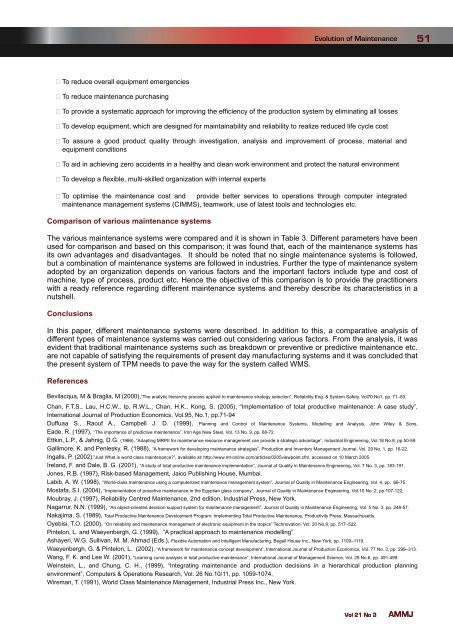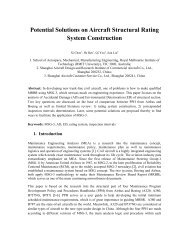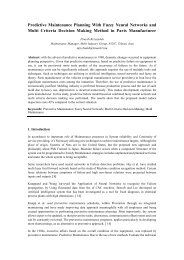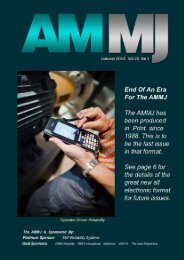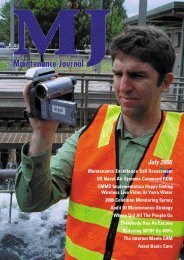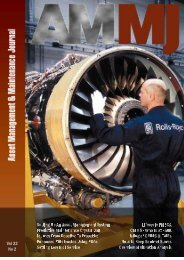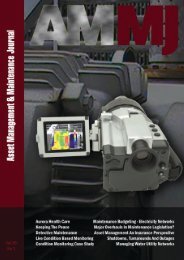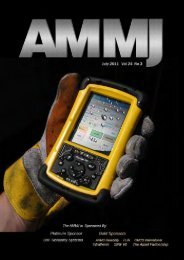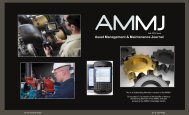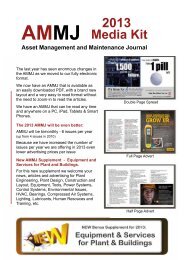DAY 1 - AMMJ
DAY 1 - AMMJ
DAY 1 - AMMJ
- No tags were found...
Create successful ePaper yourself
Turn your PDF publications into a flip-book with our unique Google optimized e-Paper software.
Evolution of Maintenance51 To reduce overall equipment emergencies To reduce maintenance purchasing To provide a systematic approach for improving the efficiency of the production system by eliminating all losses To develop equipment, which are designed for maintainability and reliability to realize reduced life cycle cost To assure a good product quality through investigation, analysis and improvement of process, material andequipment conditions To aid in achieving zero accidents in a healthy and clean work environment and protect the natural environment To develop a flexible, multi-skilled organization with internal experts To optimise the maintenance cost and provide better services to operations through computer integratedmaintenance management systems (CIMMS), teamwork, use of latest tools and technologies etc.Comparison of various maintenance systemsThe various maintenance systems were compared and it is shown in Table 3. Different parameters have beenused for comparison and based on this comparison; it was found that, each of the maintenance systems hasits own advantages and disadvantages. It should be noted that no single maintenance systems is followed,but a combination of maintenance systems are followed in industries. Further the type of maintenance systemadopted by an organization depends on various factors and the important factors include type and cost ofmachine, type of process, product etc. Hence the objective of this comparison is to provide the practitionerswith a ready reference regarding different maintenance systems and thereby describe its characteristics in anutshell.ConclusionsIn this paper, different maintenance systems were described. In addition to this, a comparative analysis ofdifferent types of maintenance systems was carried out considering various factors. From the analysis, it wasevident that traditional maintenance systems such as breakdown or preventive or predictive maintenance etc.are not capable of satisfying the requirements of present day manufacturing systems and it was concluded thatthe present system of TPM needs to pave the way for the system called WMS.ReferencesBevilacqua, M & Braglia, M (2000),“The analytic hierarchy process applied to maintenance strategy selection”, Reliability Eng. & System Safety, Vol70 No1, pp. 71–83.Chan, F.T.S., Lau, H.C.W., Ip, R.W.L., Chan, H.K., Kong, S. (2005), “Implementation of total productive maintenance: A case study”,International Journal of Production Economics, Vol.95, No.1, pp.71-94Duffuaa S., Raouf A., Campbell J. D. (1999), Planning and Control of Maintenance Systems, Modelling and Analysis, John Wiley & Sons,Eade, R. (1997), “The importance of predictive maintenance”, Iron Age New Steel, Vol. 13 No. 9, pp. 68-72.Ettkin, L.P., & Jahnig, D.G. (1986), “Adapting MRPII for maintenance resource management can provide a strategic advantage”, Industrial Engineering, Vol.18 No.8, pp.50-59.Gallimore, K. and Penlesky, R. (1988), “A framework for developing maintenance strategies”, Production and Inventory Management Journal, Vol. 29 No. 1, pp. 16-22.Ingalls, P. (2002),”Just What is world class maintenance?”, available at: http://www.mt-online.com/articles/0205viewpoint.cfm, accessed on 10 March 2005.Ireland, F. and Dale, B. G. (2001), “A study of total productive maintenance implementation”, Journal of Quality in Maintenance Engineering, Vol. 7 No. 3, pp. 183-191.Jones, R.B. (1997), Risk-based Management, Jaico Publishing House, Mumbai.Labib, A. W. (1998), “World-class maintenance using a computerized maintenance management system”, Journal of Quality in Maintenance Engineering, Vol. 4, pp. 66-75.Mostafa, S.I. (2004), “Implementation of proactive maintenance in the Egyptian glass company”, Journal of Quality in Maintenance Engineering, Vol.10 No. 2, pp.107-122.Moubray, J. (1997), Reliability Centred Maintenance, 2nd edition, Industrial Press, New York.Nagarrur, N.N. (1999), “An object-oriented decision support system for maintenance management”, Journal of Quality in Maintenance Engineering, Vol. 5 No. 3, pp. 248-57.Nakajima, S. (1989), Total Productive Maintenance Development Program: Implementing Total Productive Maintenance, Productivity Press, Massachusetts.Oyebisi, T.O. (2000), “On reliability and maintenance management of electronic equipment in the tropics” Technovation, Vol. 20 No.9, pp. 517–522.Pintelon, L. and Waeyenbergh, G. (1999), “A practical approach to maintenance modelling”Ashayeri, W.G. Sullivan, M. M. Ahmad (Eds.), Flexible Automation and Intelligent Manufacturing, Begell House Inc., New York, pp. 1109–1119.Waeyenbergh, G. & Pintelon, L. (2002), “A framework for maintenance concept development”, International Journal of Production Economics, Vol. 77 No. 3, pp. 299–313.Wang, F. K. and Lee W. (2001), “Learning curve analysis in total productive maintenance”, International Journal of Management Science, Vol. 29 No.6, pp. 491-499.Weinstein, L., and Chung, C. H., (1999), “Integrating maintenance and production decisions in a hierarchical production planningenvironment”, Computers & Operations Research, Vol. 26 No.10/11, pp. 1059-1074.Wireman, T. (1991), World Class Maintenance Management, Industrial Press Inc., New York.Vol 21 No 23<strong>AMMJ</strong>


